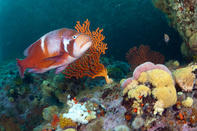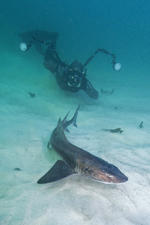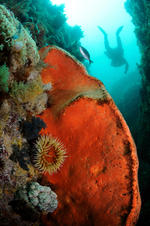Pope's Nose
Average depth: 7m / Maximum depth: 13m
This reef has big boulders of smooth rock with large crevices and a nice swim-through formed by an arch in the rock just above the ocean floor. Kelp is found in between and on the rocks with sand patches between the boulders.

You are greeted by clear blue water with a kelp forest to swim through before you get to the Pope’s Nose where there are rows and rows of colourful Cape urchins, dark Brittlestars, Feather stars and various shapes and colours of Starfish.
The Dark shyshark can be found amongst the kelp - they are curious and playful - and fish such as the Red Roman, Zebra, Rocksuckers and Steenbras are also found in this area. On a sunny day this reef looks like a fairyland and because it is quite shallow, the light penetration brings out all the colours creating a feast for the eye.
Outer Castle

Average depth: 15m / Maximum depth: 25m
Apart from the cave at this reef, there is also a really great swim-through which you have to time right otherwise the surge can shoot you out like a bullet. The reef is covered in typical False Bay marine life, including large rays and Gully sharks. The reef is alive with colours and some deep fish such as Yellowtail can be seen passing by. This spot is usually calm after a north-westerly wind has blown and flattened the sea.
Whittle Rock
Average depth: 20m / Maximum depth: 35m
At this site, a large pinnacle called Whittle Rock rises to within 3m of the surface. The reef is almost unspoilt, as the area is not dived too often. The invertebrate life is very colourful and this site teems with deep-water fish, such as Yellowtail, Roman and Stumpnose that often attract large sharks. Quite a few divers have spotted inquisitive Great white sharks cruising past.
Castle Rocks
Average depth: 6m / Maximum depth: 11m
This area has big, smooth boulders with crevices big enough to swim through as well as a few sand patches between the heaps of boulders. This is a very nice dive spot which has beautiful scenery on a sunny day. Two of the smallest shark species have been found on this reef, namely the Leopard catshark and the Dark shyshark. Amongst the kelp you can spot Speckled klipfish, Horned rockskippers and Blennies, but also keep a lookout under the ledges for peculiar looking Rocksuckers. This is one of the spots where the Doublesash butterflyfish can be found, along with the most beautiful coloured anemones and Cape urchins.
Partridge Point

Average depth: 15m / Maximum depth: 20m
This site has a sandy bottom with a magnificent maze of gullies, overhangs, caves and swim-throughs. On top of all that, the underwater scenery is enough to take your breath away. A resident colony of friendly and inquisitive seals tends to follow the divers around as they explore the abundance of colourful sponges and soft corals. Some of the typical False Bay marine life includes octopus, Pipefish, Janbruin, Klipfish and Shysharks.
Batsata Rock
Average depth: 18m / Maximum depth: 30m
Batsata Rock has very nice underwater scenery with pinnacles and gullies that slope down to 30m, making it an ideal multi-level dive. A shallow flat rock surface makes it easier for the underwater photographers. The rocks in this area are covered with lush and colourful marine growth and fish are in abundance. The coral and marine life found here is typical of False Bay. Batsata Rock is located on the southern end of Smitswinkel Bay.
By Johan Boshoff False Bay is so named because many sailors returning from the East used to mistake Cape Hangklip (near Hermanus) for Cape Point. As a result...
False Bay is so named because many sailors returning from the East used to mistake Cape Hangklip (near Hermanus) for Cape Point. As a result... Self drive routes from Cape Town invite visitors to the Mother City to experience the natural splendour, fun activities and scenic attractio...
Self drive routes from Cape Town invite visitors to the Mother City to experience the natural splendour, fun activities and scenic attractio...